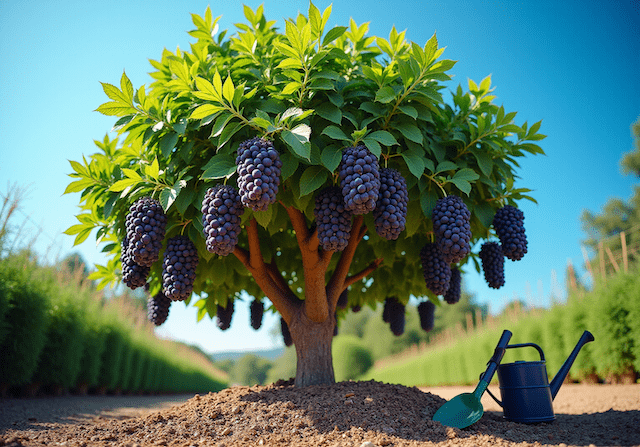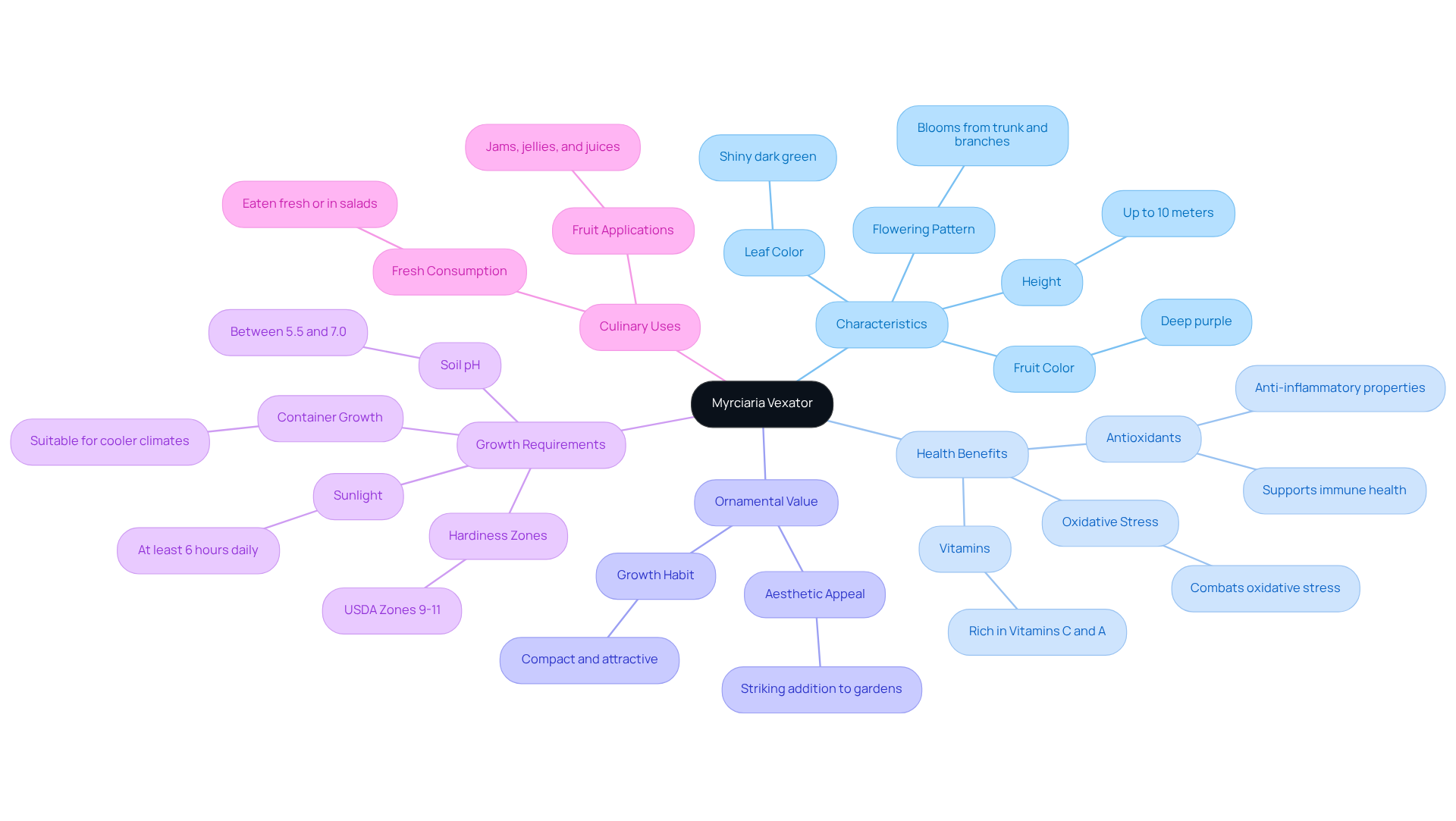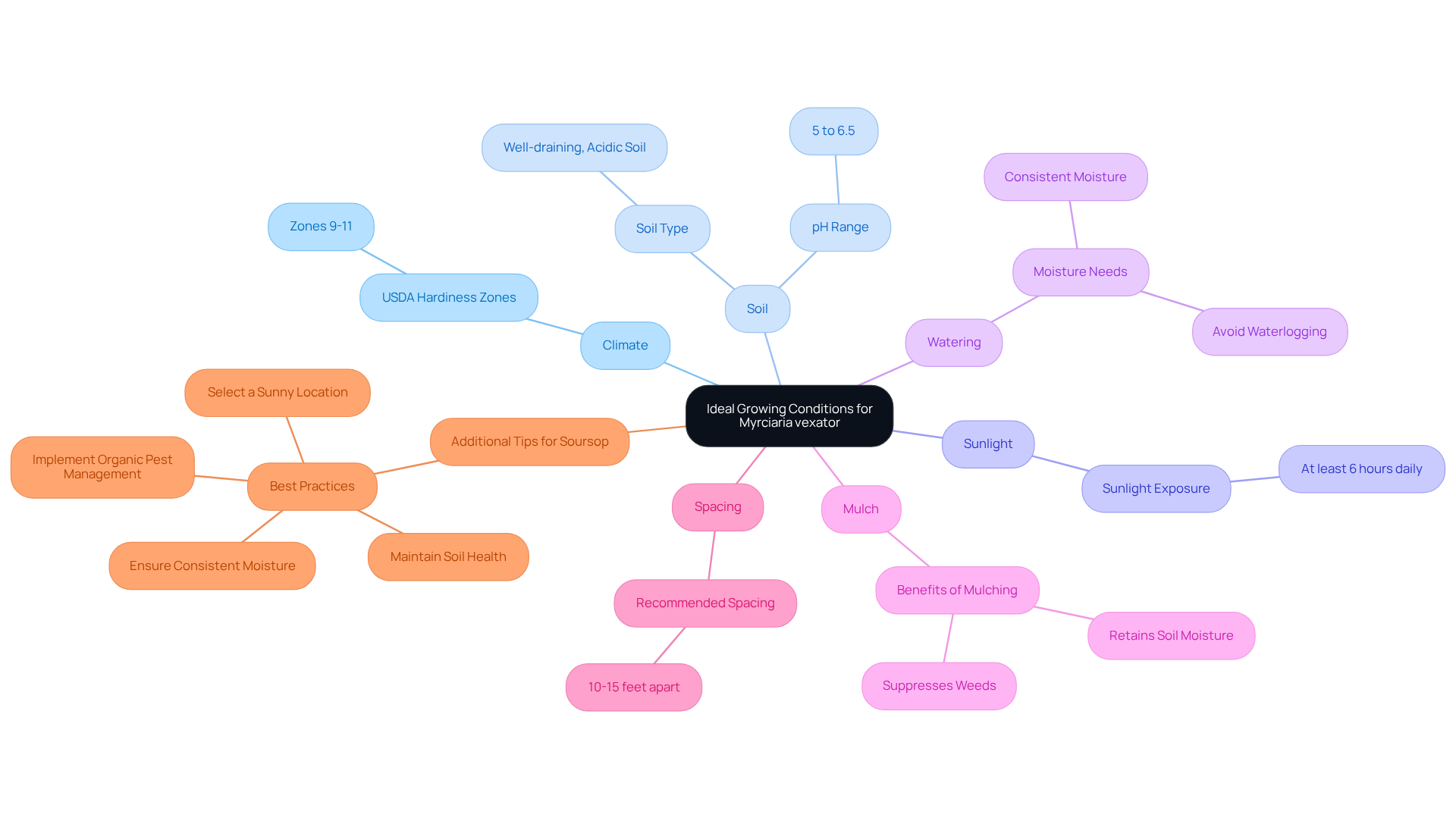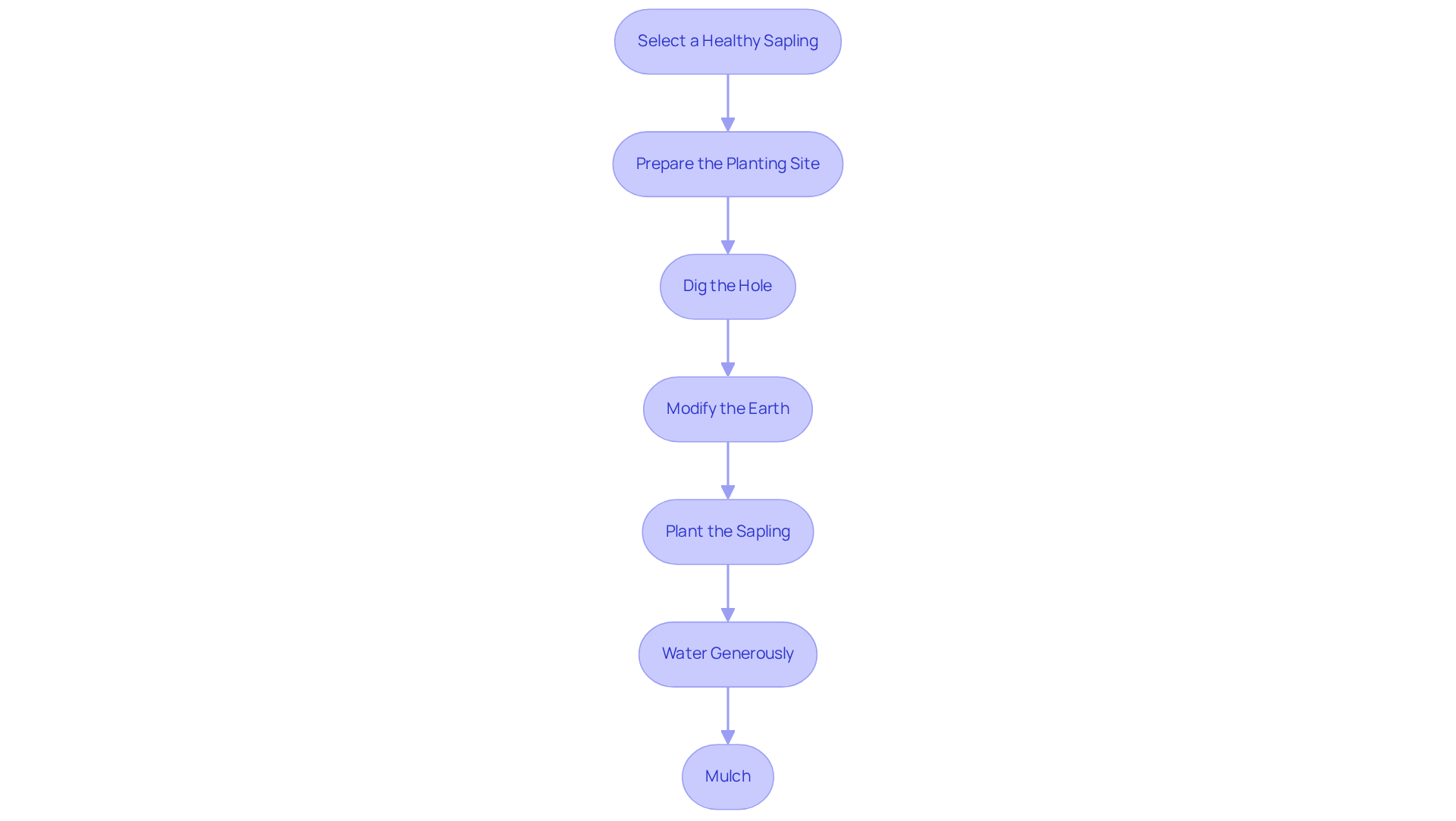
Grow Myrciaria Vexator: Essential Steps for Home Gardeners
Share
Myrciaria vexator, commonly known as the blue grape or false jaboticaba, is a fascinating evergreen tree that combines aesthetic appeal with nutritional advantages, making it an attractive option for home gardeners. This tropical gem produces unique fruit that is abundant in vitamins and antioxidants, enhancing any garden while offering delightful culinary possibilities. However, cultivating Myrciaria vexator comes with its own set of challenges. Therefore, what are the essential steps to ensure successful growth and fruit production in a home garden?
Want to grow a Blue grape tree in your garden?
Explore Blue Grape Tree (Myrciaria Vexator) for sale at Everglades Farm - shipped directly from Florida.
Understand Myrciaria Vexator: Key Characteristics and Benefits
The slow-growing evergreen tree, Myrciaria vexator, commonly known as the blue grape or false jaboticaba, can reach heights of up to 10 meters. It features shiny, dark green leaves and produces small, grape-shaped fruits that ripen to a deep purple hue, typically ready for harvest in late spring or early autumn. In addition to its delicious fruit, the Myrciaria vexator is appreciated for its ornamental beauty, making it a striking addition to any garden.
The fruit is not only sweet and flavorful but also rich in essential vitamins C and A, along with antioxidants that contribute to various health benefits, including immune support and anti-inflammatory properties. Research underscores the antioxidant potential of Myrciaria vexator, indicating that its bioactive compounds may assist in combating oxidative stress and promoting overall well-being.
Notably, the Myrciaria vexator showcases a unique flowering pattern, with blossoms emerging directly from the trunk and branches, creating a visually stunning display that enhances its ornamental appeal. This combination of aesthetic charm and health benefits positions the Myrciaria vexator as an excellent choice for home gardeners looking to diversify their tropical produce offerings.
For optimal growth, it requires at least 6 hours of direct sunlight daily and thrives in USDA hardiness zones 9-11. Furthermore, it takes approximately 10 years to yield fruit and can be cultivated in containers, making it accessible for gardeners in cooler climates. The fruit can also be used in various culinary applications, such as jams, jellies, and juices. At Everglades Farm, Myrciaria vexator is available, and with our high-quality fertilizers, home gardeners can ensure optimal care for their plants, enhancing growth and fruit production.

Establish Ideal Growing Conditions: Climate, Soil, and Sunlight Requirements
Myrciaria vexator is particularly suitable for USDA hardiness zones 9-11, as it thrives in warm, humid tropical and subtropical climates. This plant prefers well-draining, acidic soil with a pH range of 5 to 6.5.
When selecting a planting location, it is essential to ensure that the area receives full sun to partial shade, providing at least 6 hours of sunlight daily. Consistent moisture is crucial, especially during the establishment phase, necessitating regular watering. It is important to avoid waterlogged conditions, as excess moisture can lead to root rot.
Applying mulch around the base of the plant helps retain soil moisture and suppress weeds, creating an ideal environment for robust growth. Furthermore, trees should be spaced 10-15 feet apart to allow for proper expansion and development.
It is vital to be aware of potential cold snaps in your area because Myrciaria vexator has no frost tolerance. To promote healthy growth, a balanced, slow-release fertilizer should be applied every 6-8 weeks during the growing season.
For those also interested in planting soursop, similar best practices apply:
- Select a sunny location
- Maintain soil health
- Implement organic pest management strategies
- Ensure consistent moisture to cultivate a thriving tropical garden.

Plant Myrciaria Vexator: Step-by-Step Planting Instructions
-
Select a healthy sapling by choosing a Myrciaria vexator sapling from a reputable nursery, ensuring it shows no signs of disease or pests. A robust sapling is crucial for successful growth, as it lays the foundation for a thriving plant.
-
Prepare the Planting Site: Identify a location that receives full sun and has good drainage. Clear the area of weeds and debris to create an optimal environment for your new plant, which is essential for its health and development.
-
Dig the Hole: Dig a hole that is twice the width and the same depth as the root ball of the sapling. This practice enables the roots to grow freely and settle into the new ground, promoting strong establishment.
-
Modify the Earth: Improve the dug-up earth by incorporating organic material, such as compost. This enhancement not only improves drainage but also enriches the ground with essential nutrients, promoting healthy growth for your sapling.
-
Plant the Sapling: Place the sapling in the center of the hole, ensuring that the top of the root ball is level with the surrounding soil. Fill the hole with the modified earth, gently compacting it to eliminate any air pockets that could hinder root development.
-
Water Generously: After planting, water the sapling deeply to help compact the earth around the roots. Maintain steady moisture in the ground, but be cautious to prevent waterlogging, which can lead to root decay.
-
Mulch: Apply a layer of mulch around the base of the plant to retain moisture and suppress weeds. Ensure the mulch is kept a few inches away from the trunk to prevent rot and encourage robust development.

Maintain Healthy Growth: Care and Maintenance Practices
-
Watering: It is essential to keep the ground consistently moist, particularly during dry spells. Thorough watering promotes root development, but adequate drainage must be ensured to avoid waterlogging. During the establishment phase, regularly checking soil moisture is crucial to support healthy development.
-
Fertilization: Utilizing a balanced, slow-release fertilizer during the growing season is vital for promoting strong plant development and fruit production. A typical application rate is about 1 pound of granular fertilizer per plant, applied three to four times annually. For a three-year-old plant, this amount is crucial for optimal growth. Ensure the fertilizer possesses a suitable N-P-K ratio, where nitrogen is lower than potassium, to optimize nutrient uptake. As horticulturist Jeff Wasielewski highlights, "An appropriate N-P-K ratio for tropical plants is where the first number (N) is less than the last number (K)."
-
Pruning: Conducting annual pruning is important to eliminate dead or diseased branches and shape the plant for improved air circulation and light penetration. This practice not only enhances the tree's health but also promotes increased fruit yield.
-
Pest Management: Vigilantly monitoring for pests such as aphids and spider mites is necessary. Employing insecticidal soap or neem oil can effectively manage infestations. Regular inspections of leaves and stems will help identify any signs of distress early, ensuring timely intervention. Effective pest management strategies, as noted in case studies, can significantly contribute to maintaining plant health.
-
Mulching: Regularly replenishing the mulch layer is beneficial for retaining moisture and suppressing weeds. This practice also aids in regulating soil temperature, creating a more stable environment for root growth.
-
Harvesting: Fruits should be harvested directly from the tree once they reach ripeness. They can be enjoyed fresh or incorporated into various culinary dishes, showcasing their unique flavor.
Conclusion
Myrciaria vexator, with its stunning appearance and health benefits, presents an excellent opportunity for home gardeners seeking to enhance their tropical gardens. This slow-growing tree not only adds visual interest but also provides delicious, nutrient-rich fruits that can elevate various culinary creations. Understanding its unique characteristics and requirements is essential for successful cultivation.
Key insights from this guide highlight the importance of selecting the right environment for Myrciaria vexator, including optimal sunlight, soil conditions, and watering practices. Proper planting techniques, such as ensuring good drainage and incorporating organic matter, lay the foundation for healthy growth. Additionally, ongoing care through regular fertilization, pest management, and pruning will significantly contribute to the plant's vitality and fruit yield.
Ultimately, cultivating Myrciaria vexator is not just about growing a tree; it is about embracing a lifestyle of health, sustainability, and beauty in the garden. By following these essential steps and best practices, gardeners can enjoy the rewards of their efforts, from the lush greenery to the sweet fruits. Take the plunge into growing Myrciaria vexator and transform your garden into a thriving tropical oasis.
Transform Your Garden into a Tropical Paradise!
Start growing Myrciaria vexator today and enjoy delicious fruits and stunning greenery!
🛒 Buy a Myrciaria Vexator tree
🌱 About Everglades Farm
Frequently Asked Questions
What is Myrciaria vexator commonly known as?
Myrciaria vexator is commonly known as the blue grape or false jaboticaba.
What are the key characteristics of Myrciaria vexator?
Myrciaria vexator is a slow-growing evergreen tree that can reach heights of up to 10 meters, featuring shiny, dark green leaves and producing small, grape-shaped fruits that ripen to a deep purple hue.
When is the fruit of Myrciaria vexator typically ready for harvest?
The fruit is typically ready for harvest in late spring or early autumn.
What are the health benefits of the fruit from Myrciaria vexator?
The fruit is rich in essential vitamins C and A, along with antioxidants that contribute to immune support and anti-inflammatory properties, helping to combat oxidative stress.
How does Myrciaria vexator enhance ornamental appeal?
Myrciaria vexator features a unique flowering pattern, with blossoms emerging directly from the trunk and branches, creating a visually stunning display.
What are the growing conditions required for Myrciaria vexator?
Myrciaria vexator requires at least 6 hours of direct sunlight daily and thrives in USDA hardiness zones 9-11.
How long does it take for Myrciaria vexator to yield fruit?
It takes approximately 10 years for Myrciaria vexator to yield fruit.
Can Myrciaria vexator be grown in containers?
Yes, Myrciaria vexator can be cultivated in containers, making it accessible for gardeners in cooler climates.
In what culinary applications can Myrciaria vexator fruit be used?
The fruit can be used in various culinary applications, such as jams, jellies, and juices.
Where can Myrciaria vexator be purchased?
Myrciaria vexator is available at Everglades Farm, where high-quality fertilizers are also offered to ensure optimal care for the plants.


